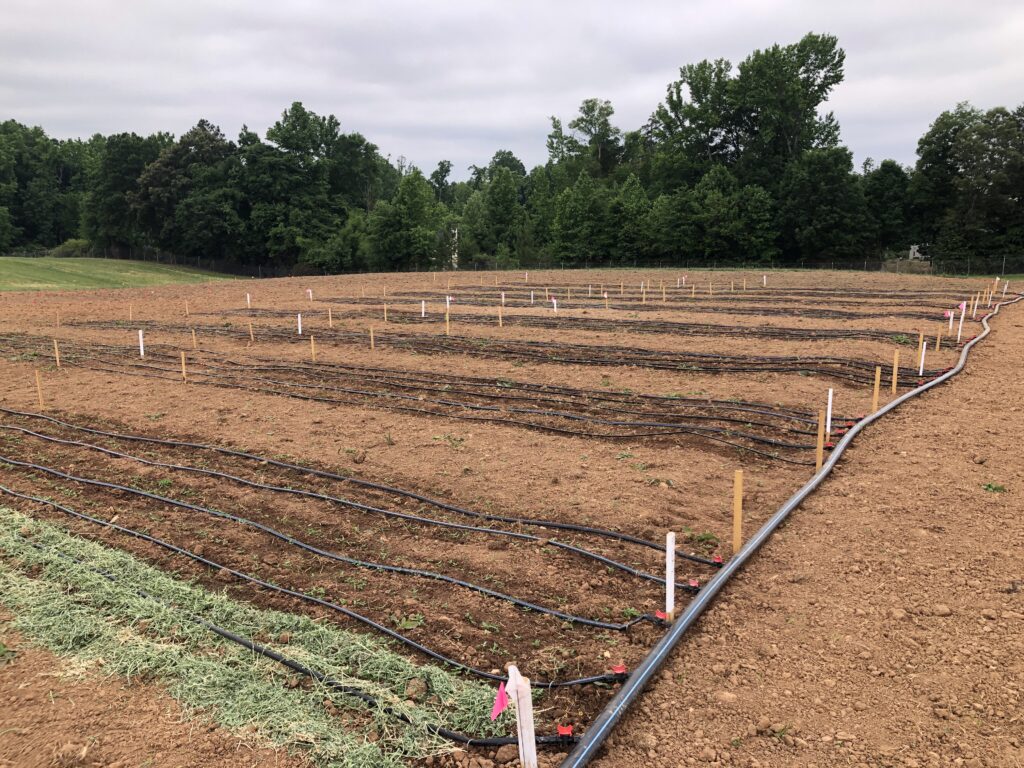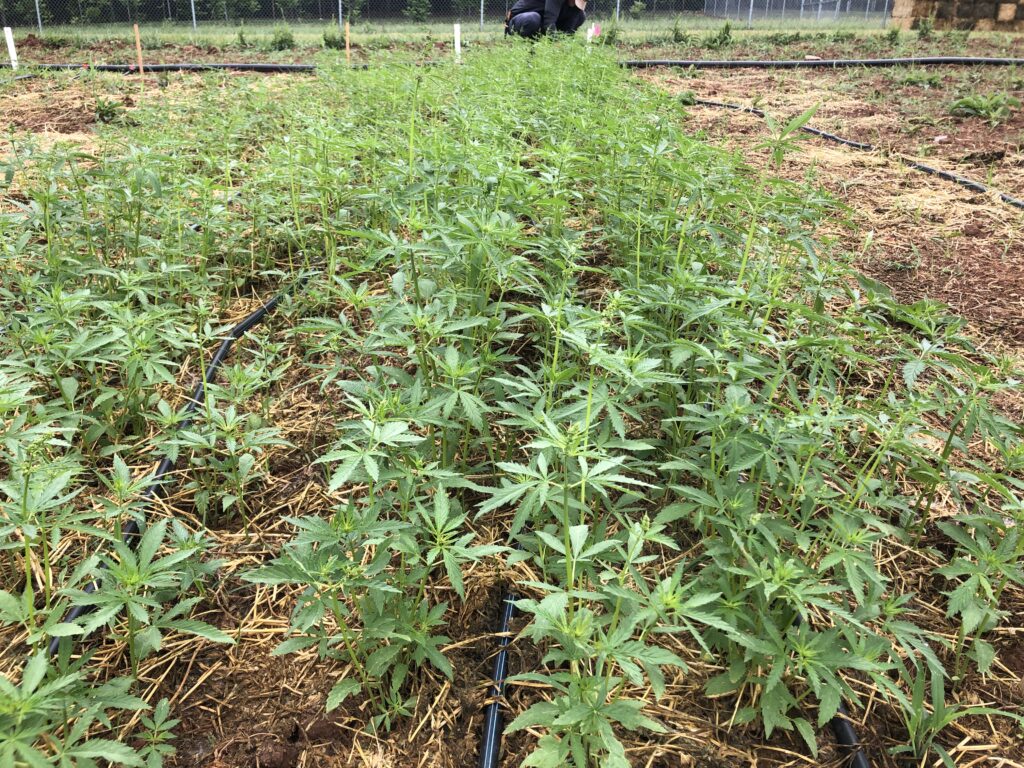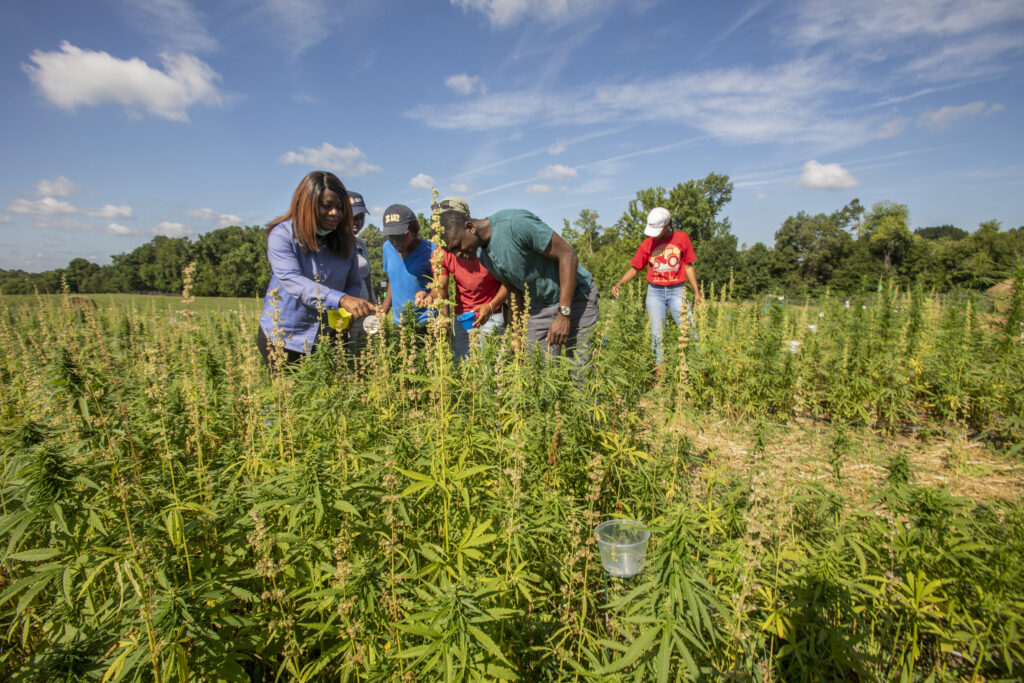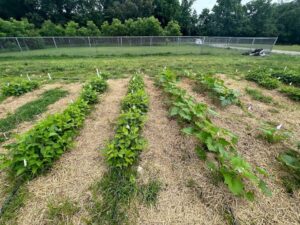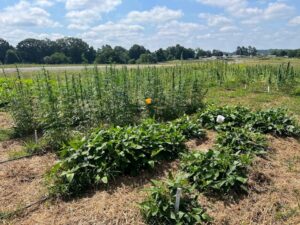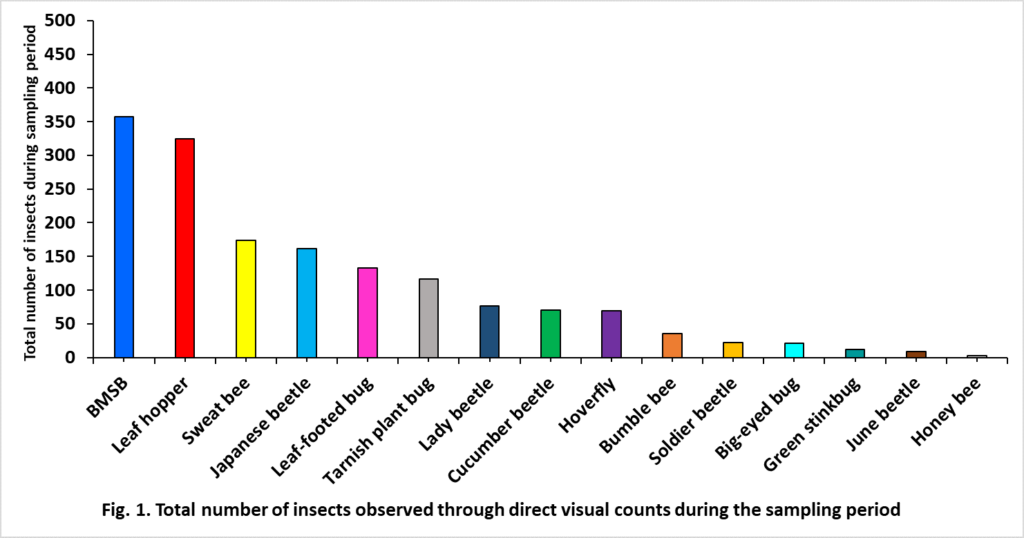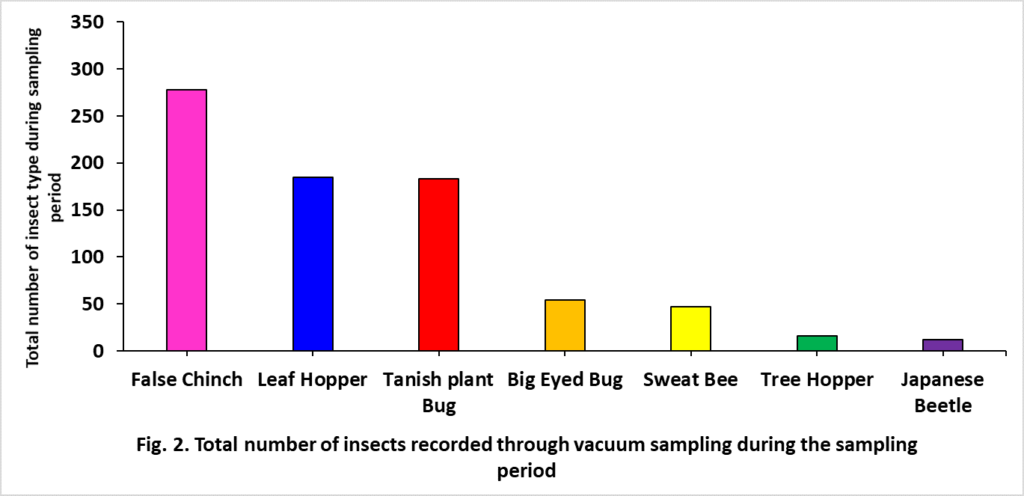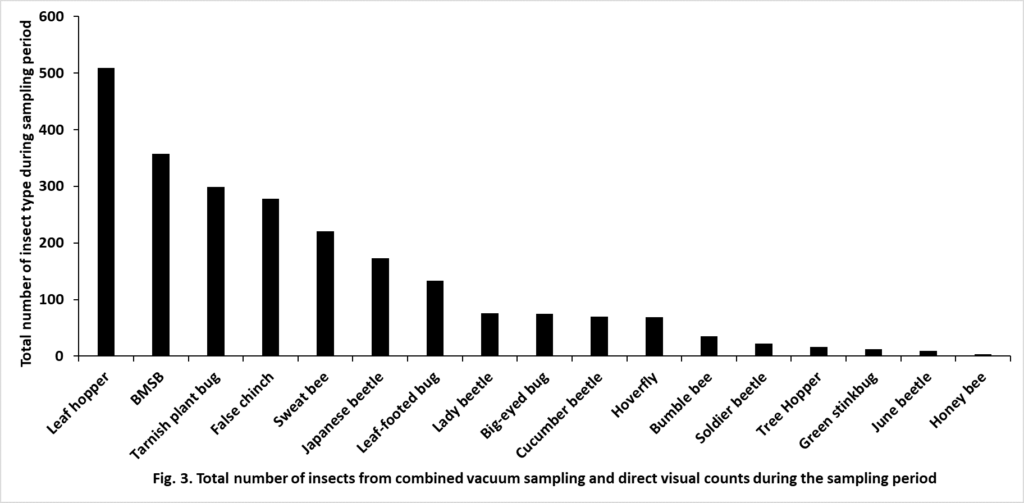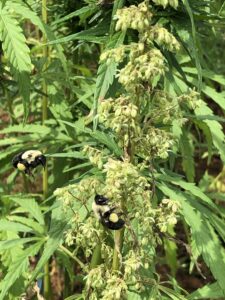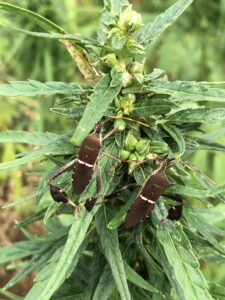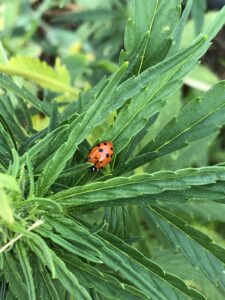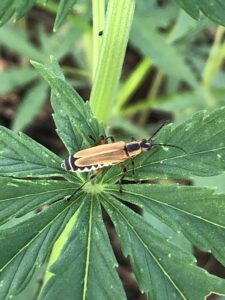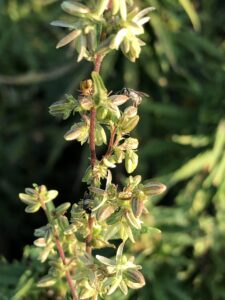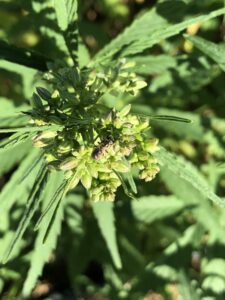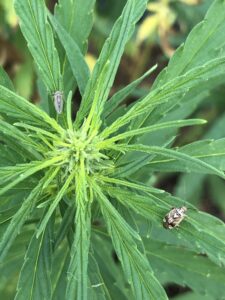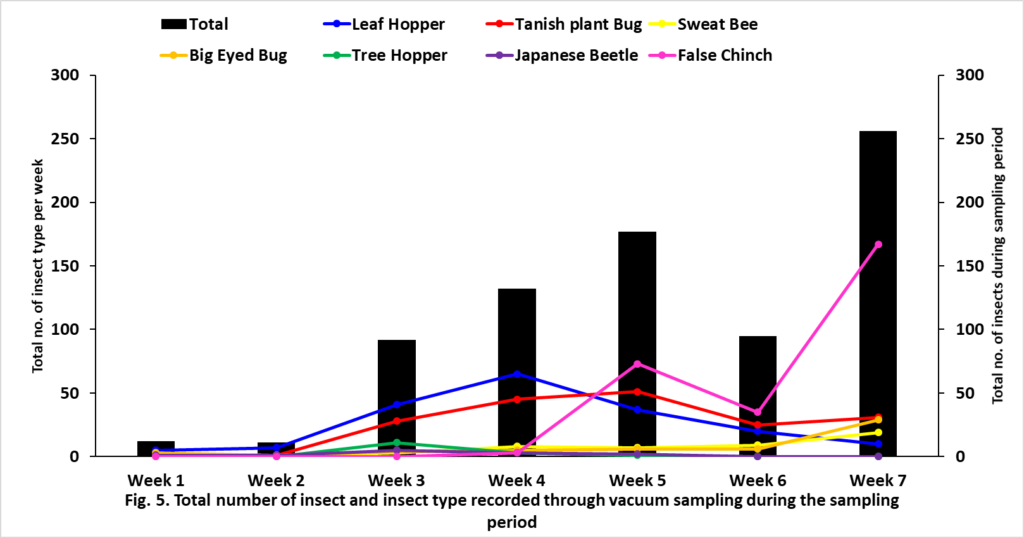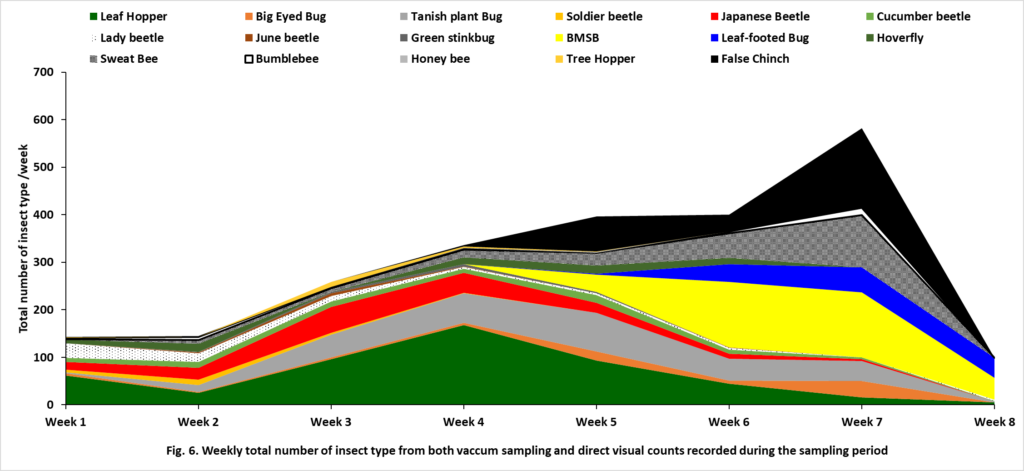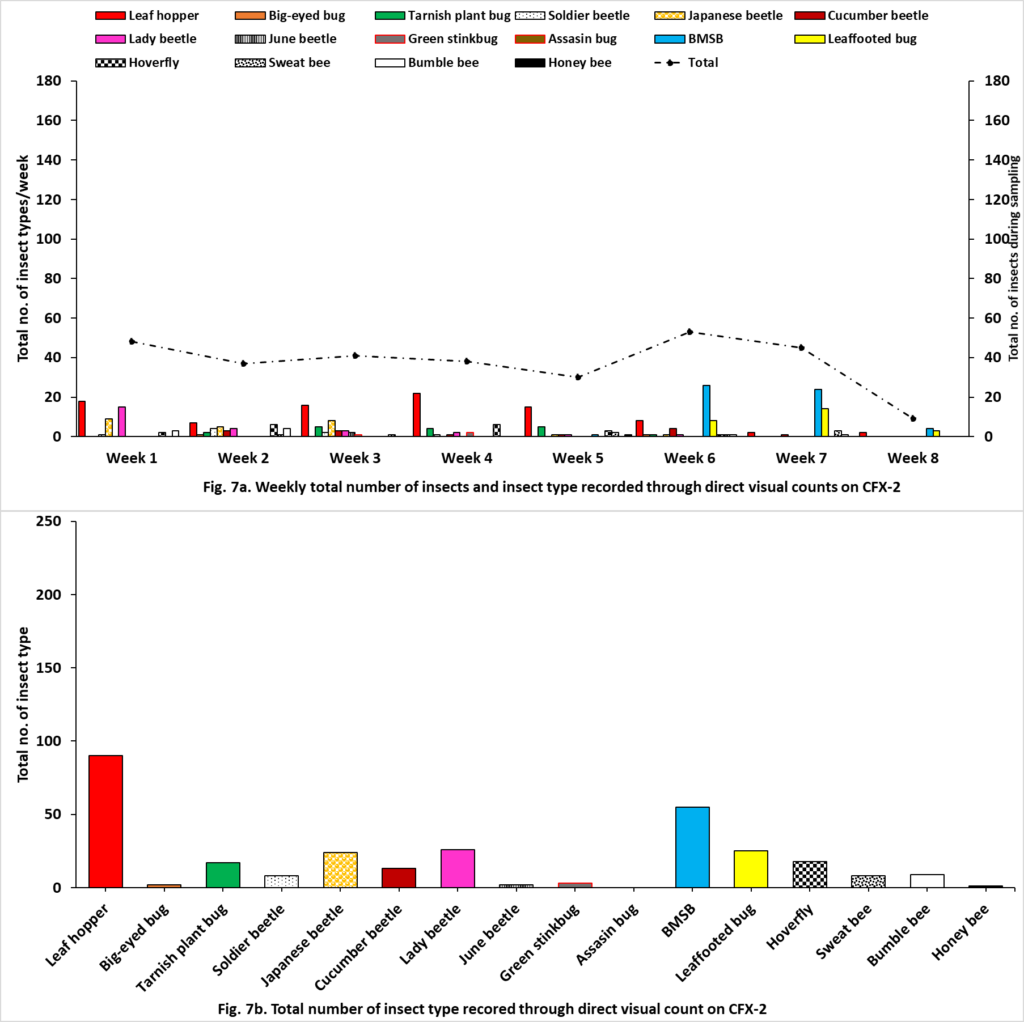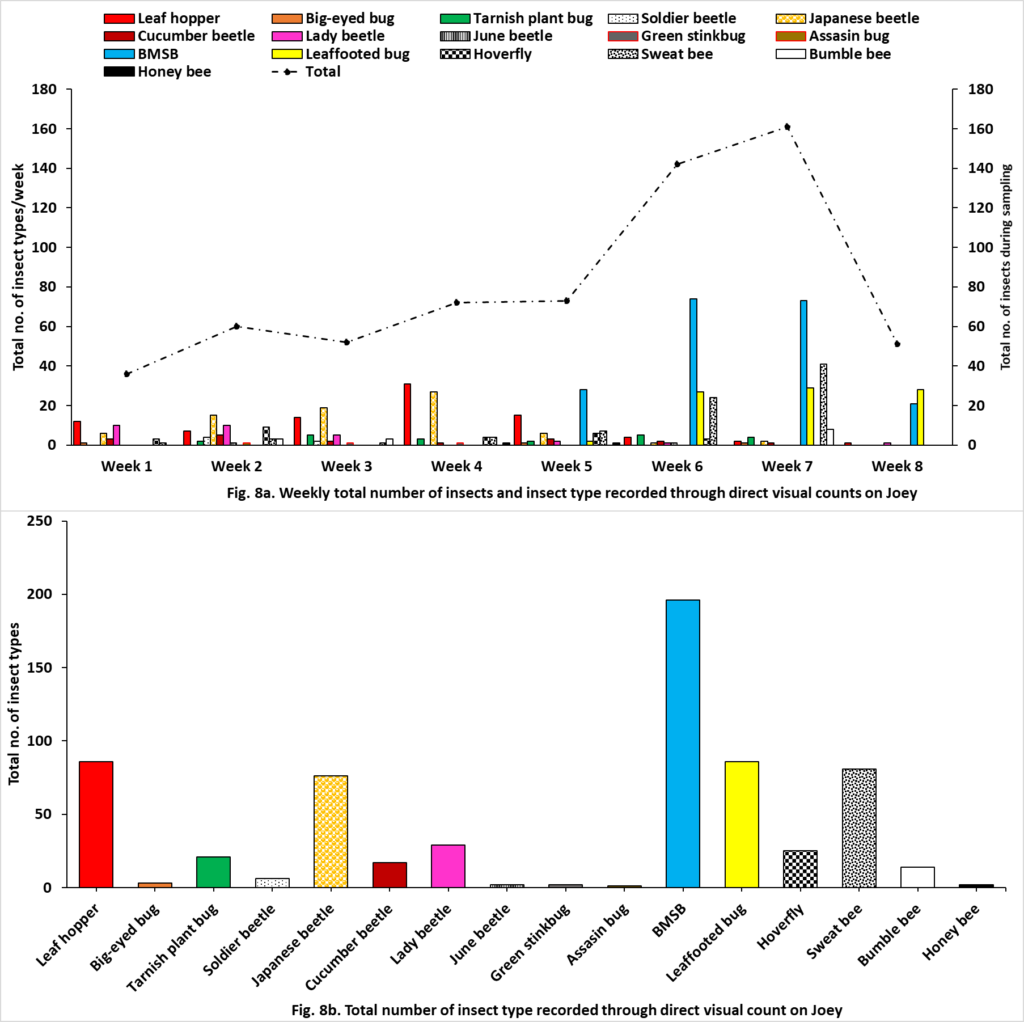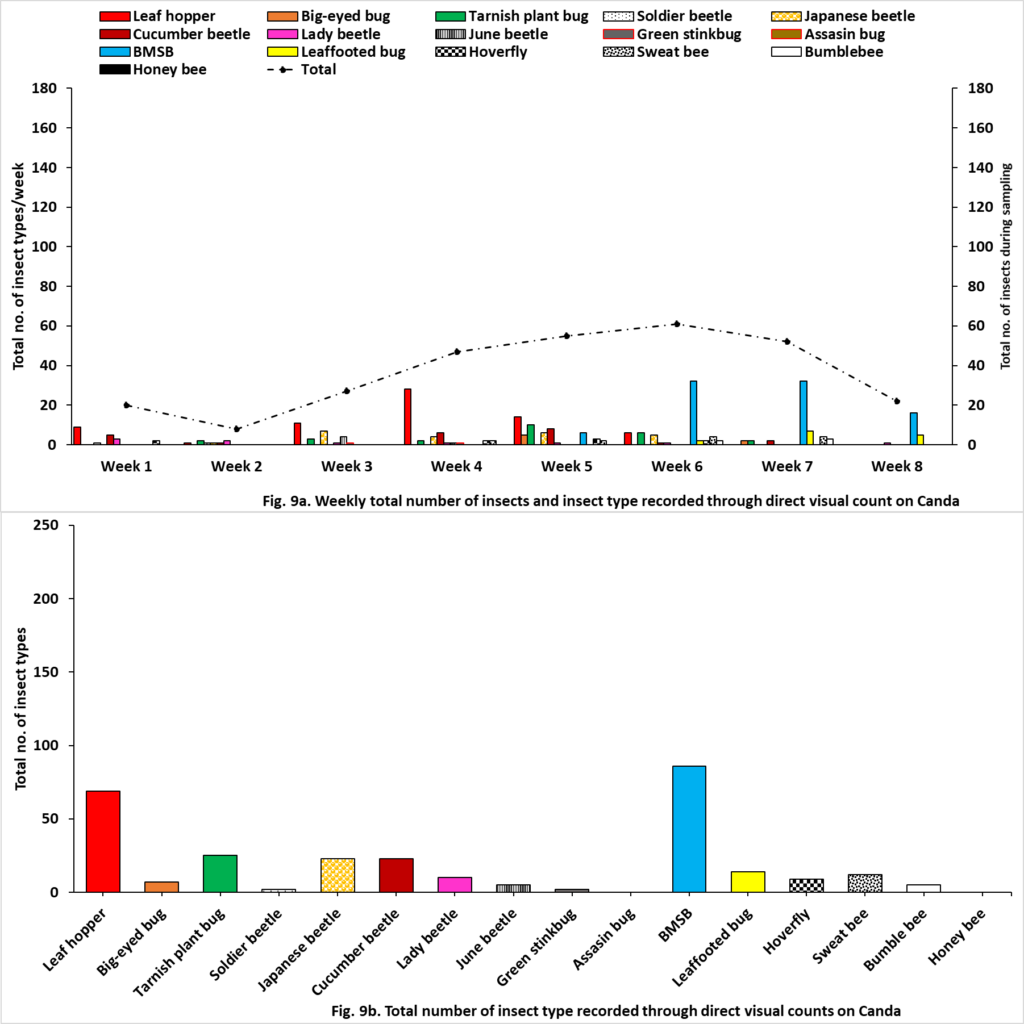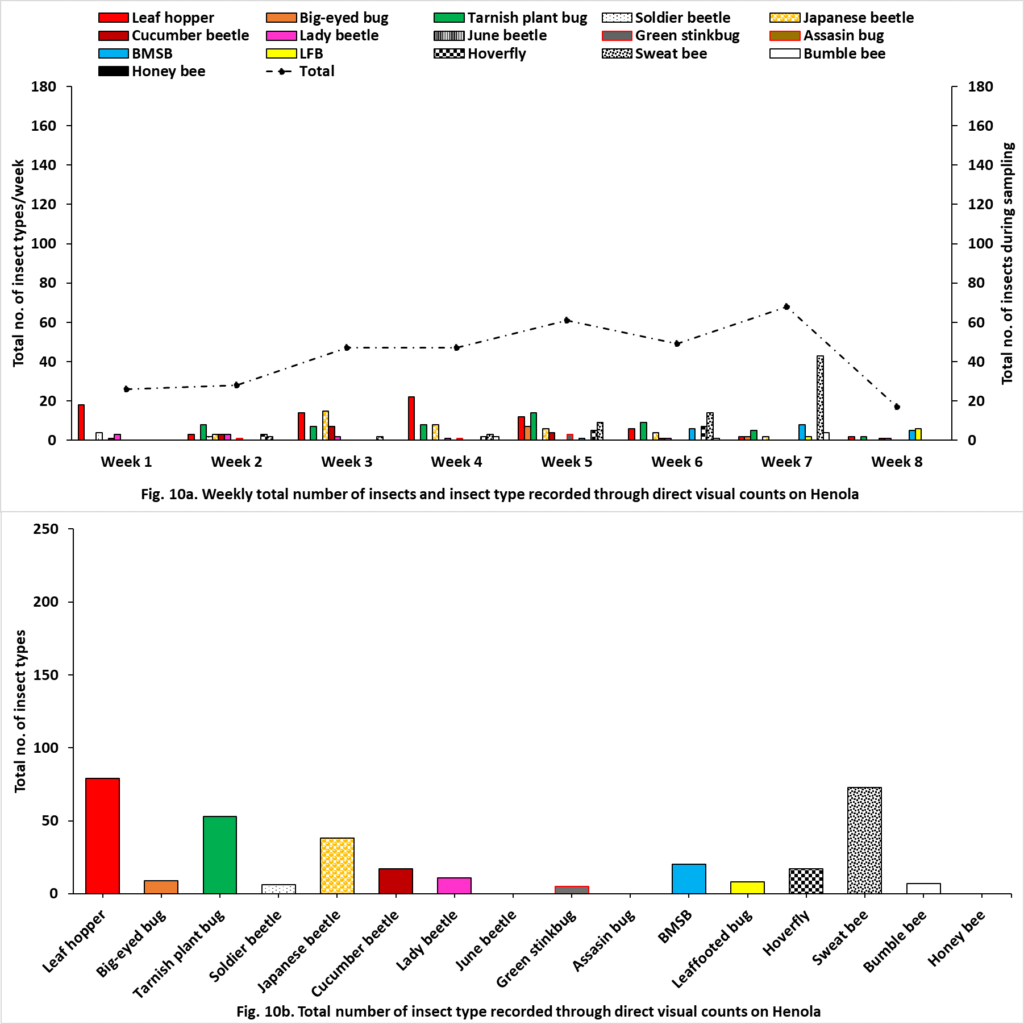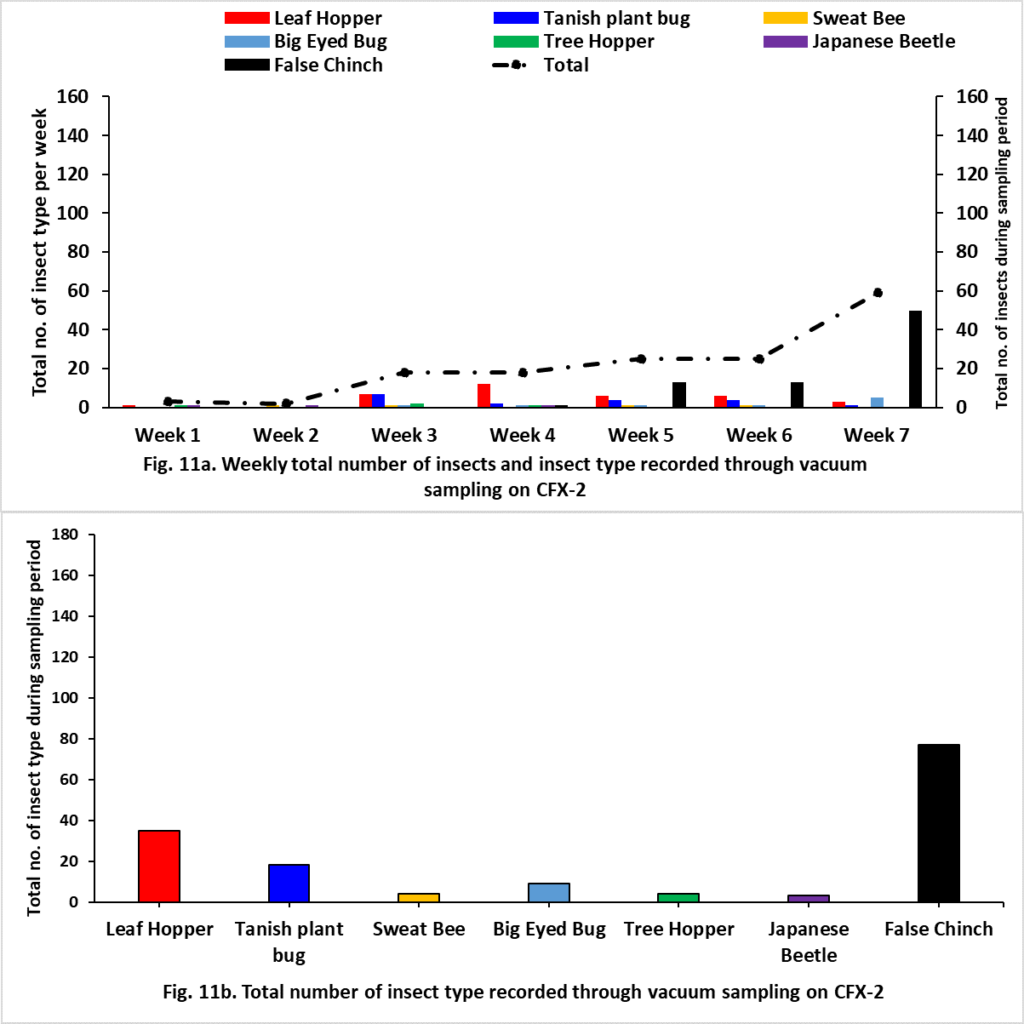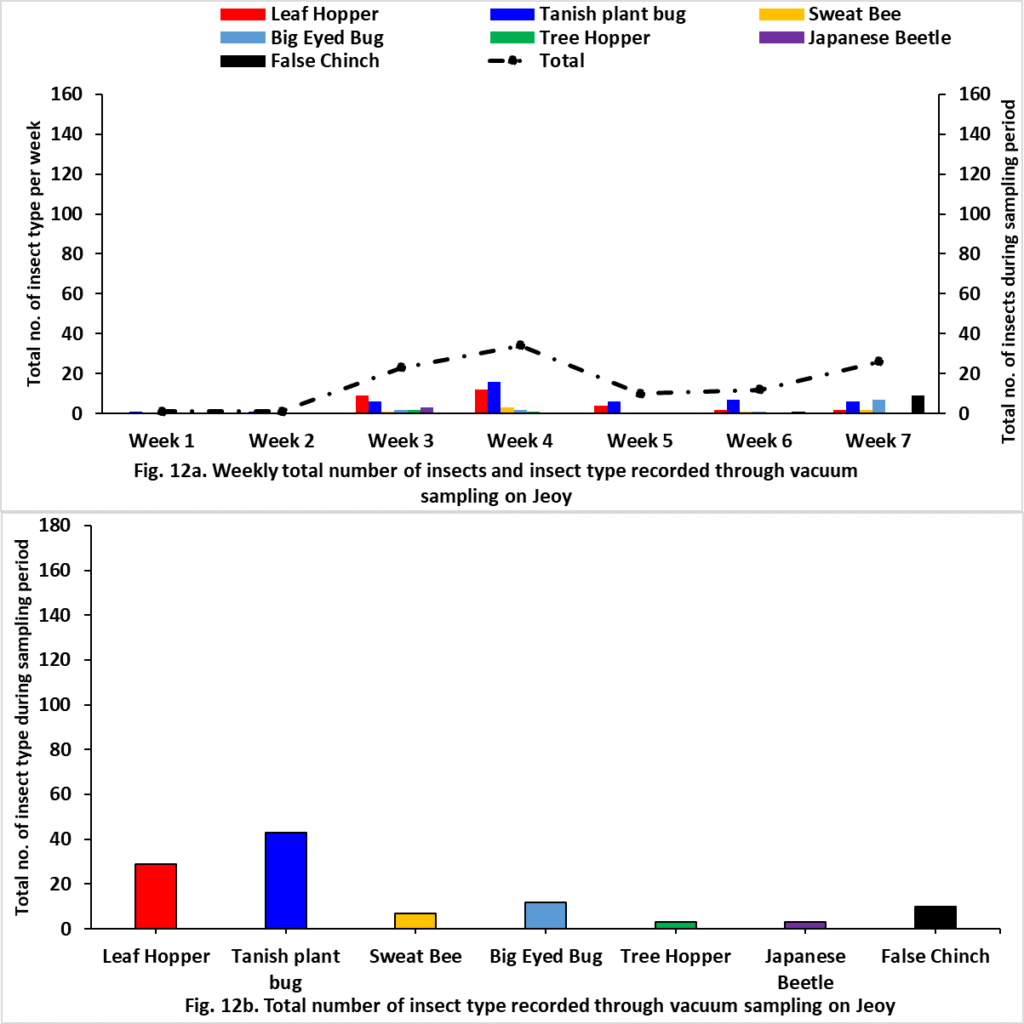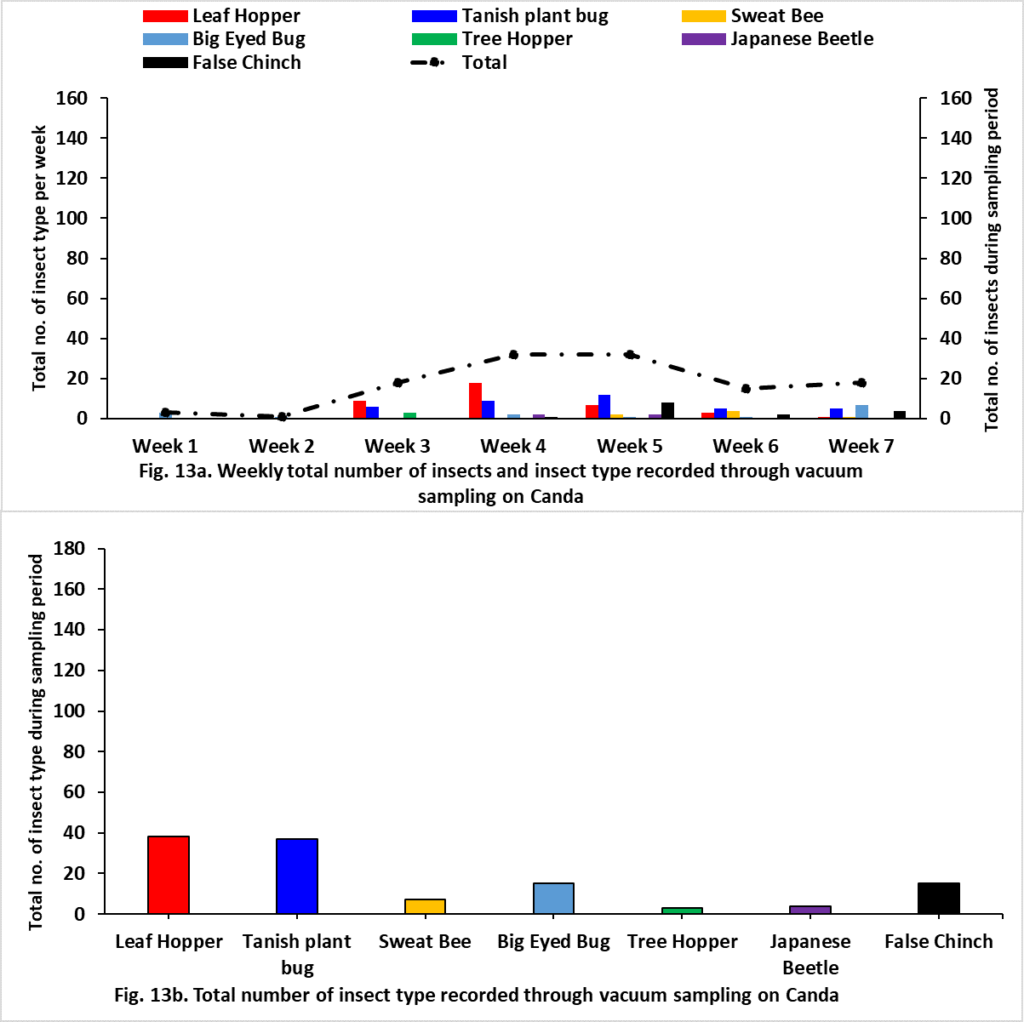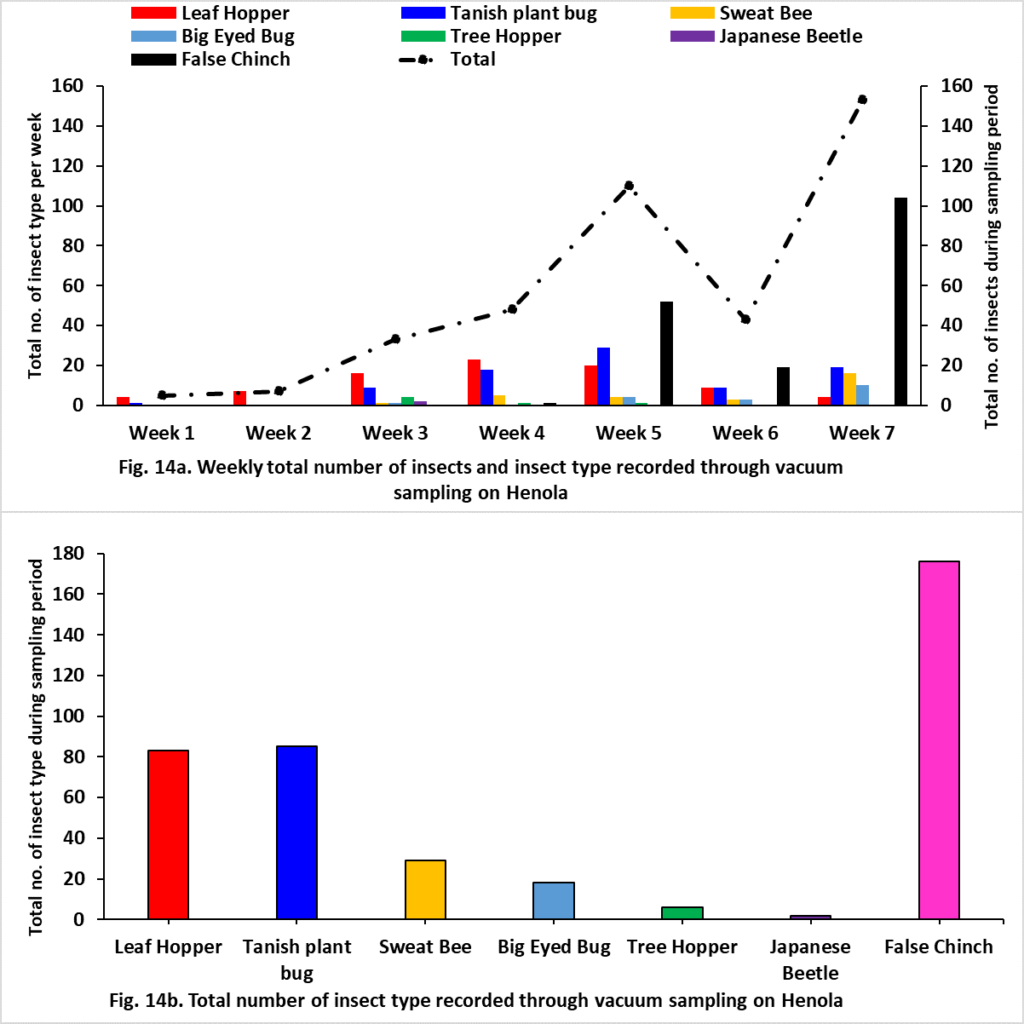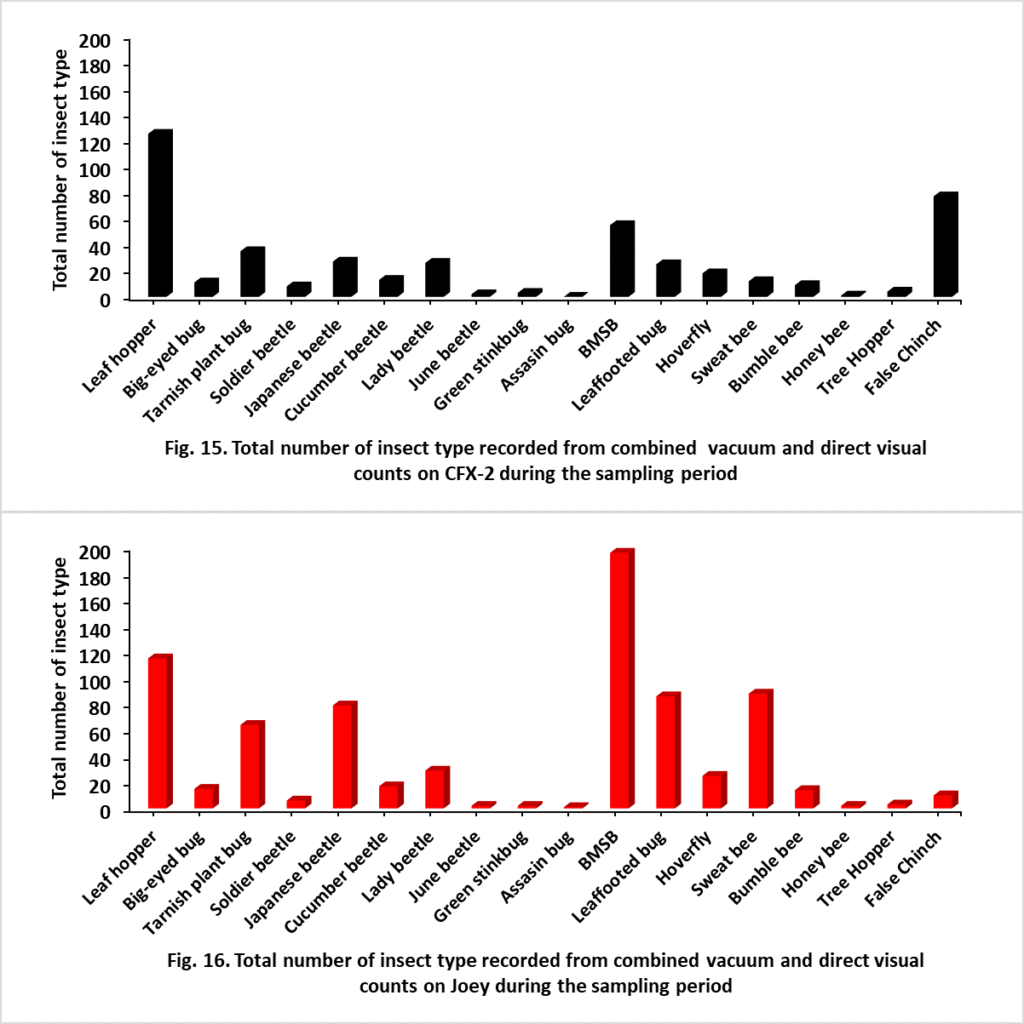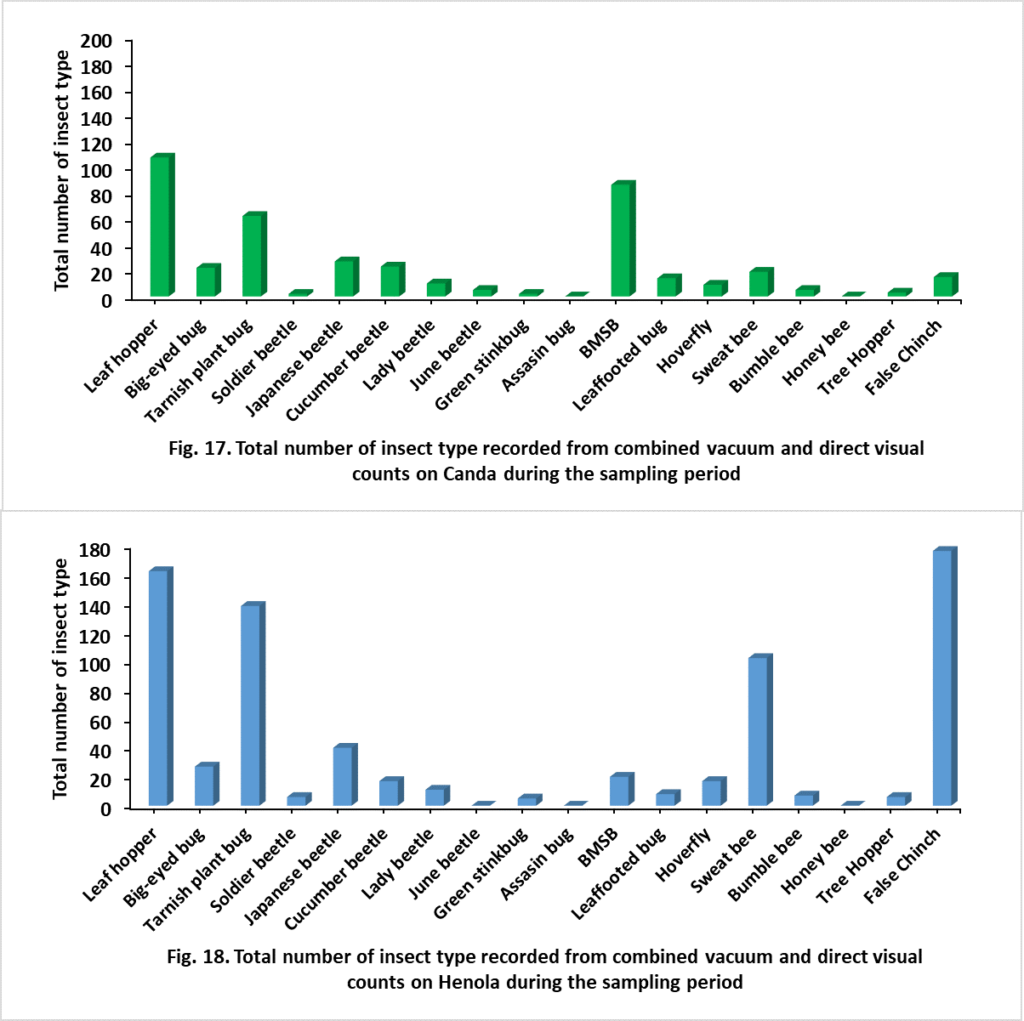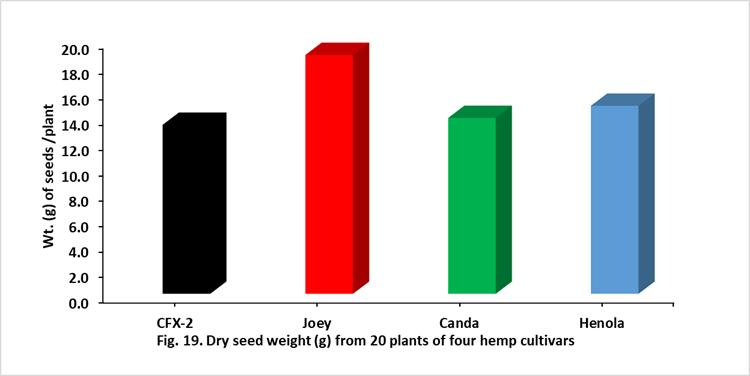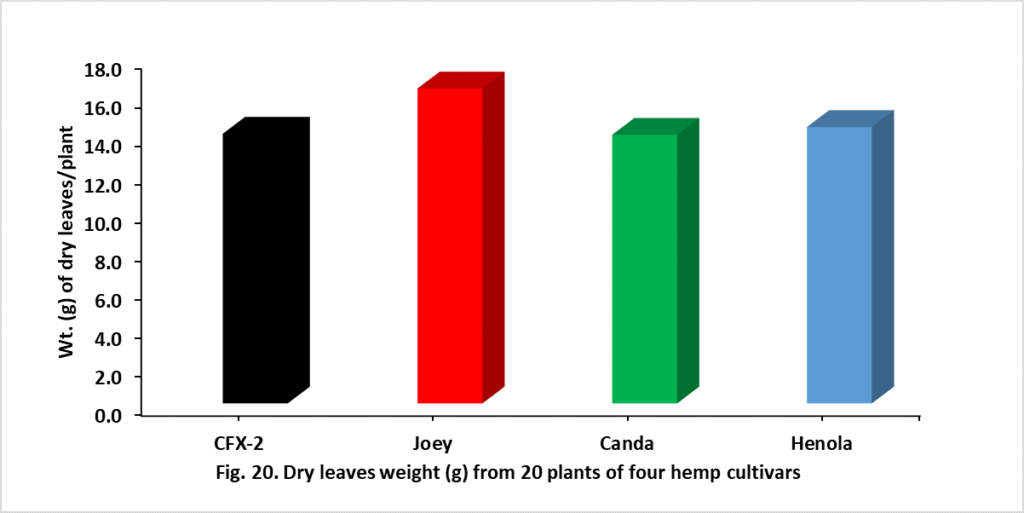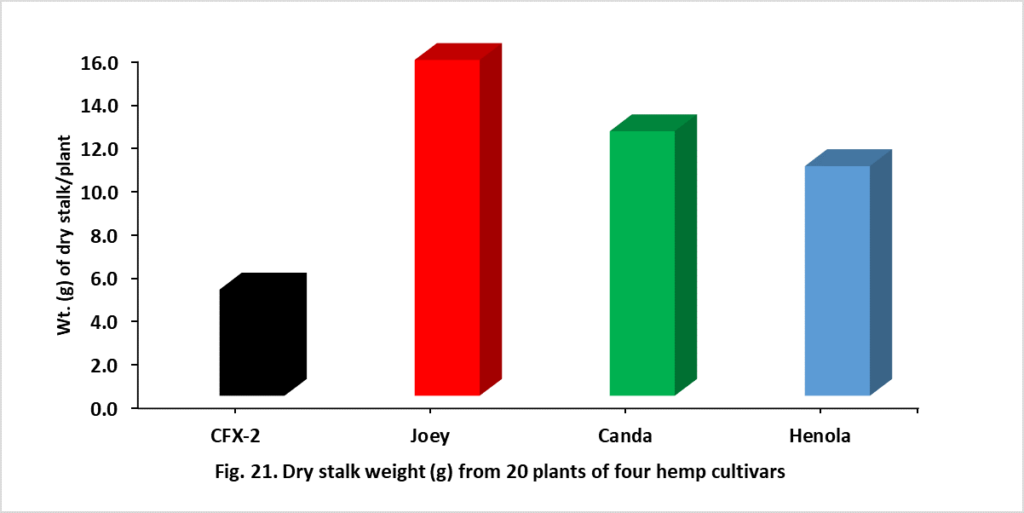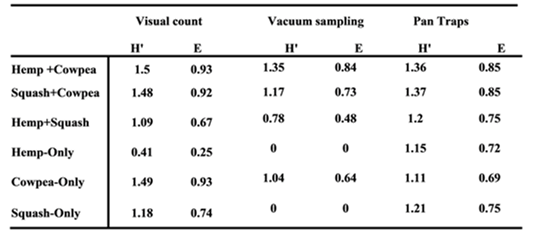Final report for LS20-333
Project Information
Industrial hemp (Cannabis sativa (L.)) is one of the oldest cultivated plants in the world grown for fiber, oilseed, and pharmaceuticals. After ≥80 years, hemp has been legalized to be grown again in the U.S; however, knowledge needed to grow hemp is limited. Research must now be initiated to ensure farmers are able to make informed decisions and avoid economic losses. The proposed experiments were developed with input from three studies by the PIs. (1). In a 2019 survey, 85% of organic farmers in NC were interested in growing hemp on their farms. Among them, 93% would grow hemp because there is a market, >84% if it fits into their current rotation, has low insect and disease pressure and diversify their farm. (2). We identified cowpea cultivars highly attractive to pollinators that increased crop yield in a vegetable intercropping system. In addition to supporting pollinator activity, cowpea fixes atmospheric nitrogen. This process can contribute a significant amount of N (>45-175lbs N/ha) to the subsequent crop thus improving soil health. (3). An ongoing soil fertility trial indicates hemp requires approximately 50-100lbs N/ha which is within the range reported for cowpea. With the soaring fertilizer prices alternative sources of soil fertility enhancers are going to be needed by farmers. For example, they can use legume such as cowpea, grown either as an intercrop or in rotation with hemp to provide the required N-level to produce higher yields. Crop rotation and intercropping are important cultural practices in crop production and pest management based on the principle of reducing pests and improving soil health. In the proposed system, pollinators would be attracted to cowpea for its nectar and hemp for pollen thus providing important ecosystem services, a component of productivity and as a forage resource. Pollinators as a whole contribute $24 billion and honey bees $15 billion to the U.S economy. However, its role in agricultural enterprise has recently been compromised by the decreasing bee populations. Since 2006, U.S beekeepers have seen >40% decline in honey bee colonies; according to NC State Beekeepers Association, there was >50% loss in 2018, impacting the state's $84 billion agriculture industry. As a countermeasure, one strategy has been to increase abundance of bee forage resources on farmlands. We propose to achieve this through intercropping and rotation using cowpea highly attractive to pollinators. The primary goal of this project is to develop a sustainable research-based strategy and communicate information on pests, pollinator activity, soil health in a cropping system perspective that will help farmers make informed decisions about hemp production. To attain this goal, we propose four specific objectives: a) identify hempseed cultivars suitable to grow in NC-reduced pests, pollinator-attractive and high yielding; b) evaluate integration of hemp into two cropping systems- crop rotation and intercropping; c) evaluate soil health indicators with respect to biological nutrient cycling and microbial community; (d) assess system profitability from best production practices derived from a-c. Overall, the proposed project will enhance hemp production through management strategies that are sustainable and cost-efficient.
Objective 1. Screen 4 industrial hemp seed cultivars to identify cultivars with high yields, reduced pests incidence suitable to grow in North Carolina
Objective 2. Evaluate the effect of integrating five agronomically desirable hemp seed cultivars (from objective 1) in an intercropping system that includes Hemp+Cowpea+Pollinator-Dependent-Crop. The pollinator-dependent-crop may include cucurbits (such as water melon, watermelon or squash) or okra.
Objective 3. Measure biological soil health dynamics with respect to microbial nutrient cycling and microbial communities in each of the two systems described in objectives 2 and 4.
Objective 4. Assess system profitability from best production practices used in objective 2 and evaluate the effect of crop rotation at collaborative farmer-managed farm and at NCAT research plot.
Cooperators
- - Producer
- - Producer
- - Producer
- - Producer
- (Educator)
- - Producer
Research
Objective 1. Screen 4 industrial hemp seed cultivars to identify cultivars with high yields, reduced pests incidence suitable to grow in North Carolina.
Experimental plots were established at the NC A&T research farm, Greensboro, NC. Four industrial hemp cultivars (Canda, CFX-2, Joey and Henola) were grown at NC A&T on May 18th, 2021. Each treatment was planted in 10 rows, each 7 m long with 7.5 inches inter-row spacing and replicated 4 times in a Randomized Complete Block Design (RCBD).
Insect sampling: Sampling was focused mainly on pests and pollinators (bees). However, other captured beneficial insects were also recorded. Visual observation of insects: For each treatment, the two 10m rows were observed for 2 minutes each for pollinators and other insects. Observations were conducted weekly for eight weeks and data was recorded on the number of insects. Vacuum sampling: This was conducted using a Ryobi insect vacuum (Bioquip Product). The 10m rows for each hemp treatment was vacuumed for 30 s. Samples were placed in Ziploc bags and stored in a refrigerator and later sorted using a microscope. Evaluation of pollinators using pan trap: Pollinators were sampled within each treatment using pan traps. Traps were made from 16oz. polypropylene deli bowls painted with UV-bright fluorescent blue or yellow paint and unpainted 12oz. white styrofoam bowls. The bowls were individually glued onto a 36” plant prop using adhesive and one of each color bowl were placed between the 2 rows within each cowpea variety during the sampling period. Each bowl was filled with approximately 250mL of soapy water solution (2.5mL of detergent in 1-gallon water). Traps were set out early in the morning (8:00 -10:00 am) and collected after 24 hours weekly. Traps were collected in the order they were placed to ensure that all traps were available to insects for the same amount of time. After 24 hours each pan trap was removed and drained and content removed and placed into vials containing 70% ethanol and stored for later identification.
Unlike other crops, hemp grains easily shatter from the seed head and this can result in yield loss. At about 70% maturity plants were bagged as shown below. 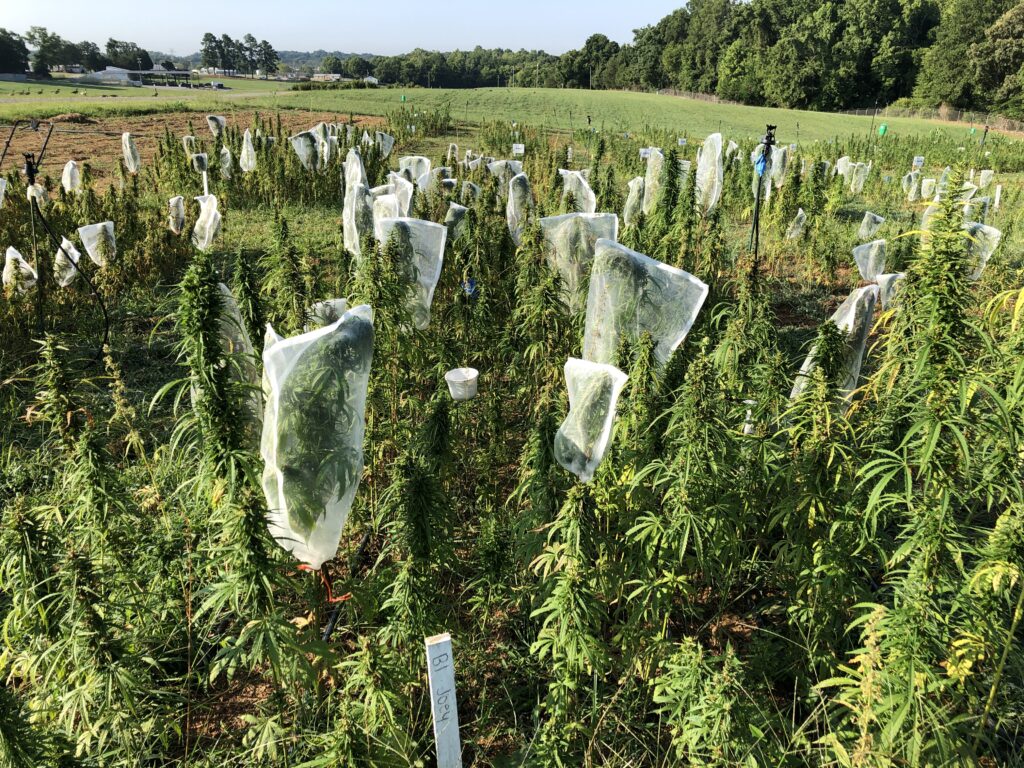
Even though plants were bagged, insect pests such as the Leaf-footed bug and the brown marmorated stink bug were observed feeding on the hemp grain through the bags.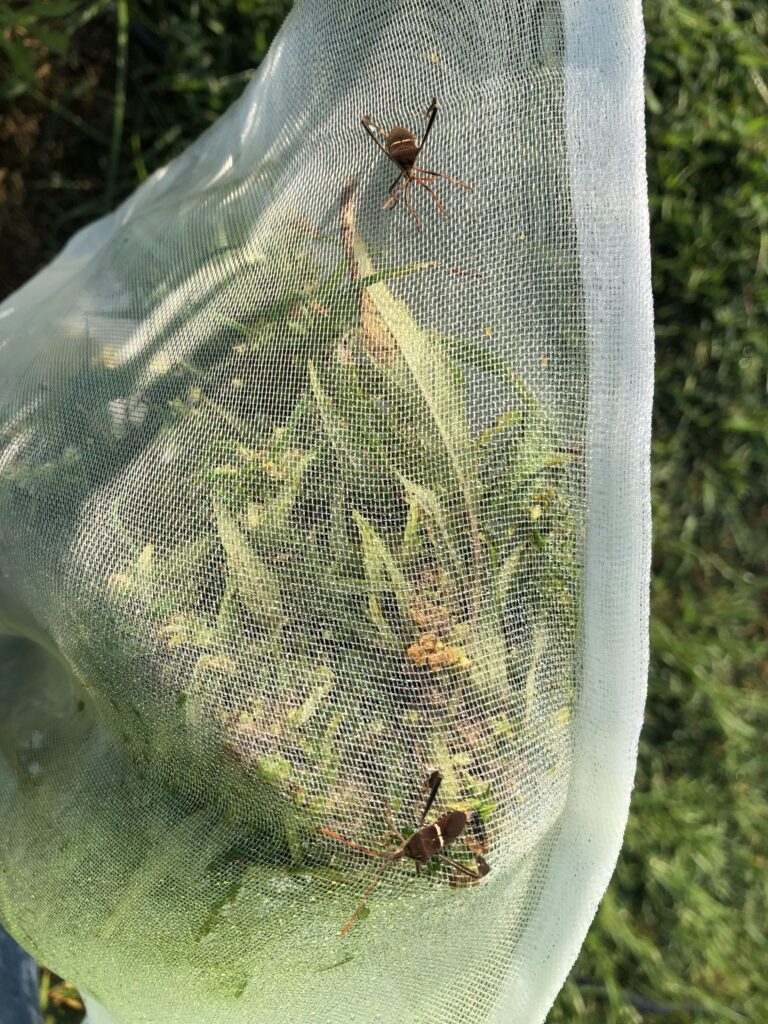
Determination of chlorophyll and sugar content in situ: Chlorophyll readings were taken weekly using a chlorophyll meter (Konica SPAD-502Plus). For each hemp treatment, five random plants were selected and measurements were taken from one leaf (highest) of each plant. Individual SPAD readings were averaged for each treatment. Data was collected weekly for five weeks. Similarly, the leaf sugar content was obtained from the leaves of five random plants using a handheld refractometer weekly beginning June 16 to July 28 for a total of four weeks.
Evaluation of agronomic performance: Plant height is one of the major indicators of plant growth and development. Plant height is positively correlated with plant grain yield and plant biomass. At 63 days after planting (DAP), the height of 10 random plants from each treatment was measured and recorded. At maturity, about 95 DAP hemp plants were harvested, sun as well as air-dried. Because of the bulk of the harvest, data for this reporting period was collected from five random plants from each treatment and from each block for a total of 20 plants. The seeds were separated from the leaves and stalks by hand and further separated using a USA standard test sieve (12" Sieve #6 and #8). Data on seed, leaf and stalk weight was collected and recorded.
Objective 2. Evaluate the effect of integrating Joey, an agronomically desirable hemp cultivar (from objective 1) in an intercropping system that includes Hemp+Cowpea+Pollinator-Dependent-Crop (squash).
The experiment had three intercrop treatments including (i) Hemp+Cowpea, (ii) Squash+Cowpea, and (iii) Hemp+Squash and three control treatments as follows (i) sole industrial hemp (Hemp-monocrop), (ii) sole squash (Squash-monocrop), and (iii) sole cowpea (Cowpea-monocrop) for a total of six treatments. The intercrop treatments comprised two rows, each 5 m long (Fig. xx), with 1m inter-row spacing and 2 m spacing between each treatment. Each treatment was replicated four times. The control treatments comprised three rows each of hemp, squash, and cowpea, and were separated by two rows of field corn. The control plot was set up 9 m away from the intercrop treatments. Crops were planted on different dates based on when they started to flower to synchronize the flowering of pollinator-attractive crops (hemp and cowpea) with that of the pollinator-dependent crop (squash).
Insect sampling: As described in Objective 1, all three sampling methods (direct visual counts, vacuum, and pan traps) were used in Objective 2.
Objective 3. Objective 3. Measure biological soil health dynamics with respect to microbial nutrient cycling and microbial communities in each of the two systems described in objective 2.
The main objective of this study was to evaluate the influence of introducing hemp into intercropping with either cowpea or squash on soil properties and the diversity of rhizosphere bacteria. As a result, we conducted a comparative analysis of three different intercropping systems: Hemp+Cowpea, Hemp+Squash, and Squash+Cowpea. Five soil cores, each with a diameter of 2.2 cm and a depth of 30 cm, were collected and combined to create composite soil samples. Sampling was conducted on May 13, (prior to planting, serving as the baseline) and on August 16 (at the time of harvest). Soil samples were sieved through a 2mm mesh to remove plant and root residues and stored at 4°C for further analysis. Soil properties measured included gravimetric water content, pH, electrical conductivity (EC), total carbon (SOC), total nitrogen (TN), nitrate nitrogen (NO3--N), ammonium nitrogen (NH4+-N) and Permanganate Oxidizable Carbon (POXC). Soil biological properties such as potential activities of β-glucosidase activity (BGA), N-acetyl glucosaminidase (NAG), along with soil test biological activity (STBA) were also assessed. During the harvest, rhizosphere soil samples were collected from the hemp plants and subsequently extracted DNA using the DNeasy Powerlyzer PowerSoil Kit (Qiagen, Germantown, MD, USA) following the manufacturer's instructions. The role of cropping systems on soil properties were tested in a one-way analysis of variance (ANOVA) (when parametric assumptions were satisfied) or Kruskal-Wallis test (when assumptions were violated), with significance criterion set at 5%.
Objective 4. Assess system profitability from best production practices used in objective 2 on demonstration plots setup and managed exclusively by the participating farmers and at the university farm and evaluate the effect of crop rotation by rotating cowpea plots in previous year (objective 2) with hemp and hemp with cowpea. (Year 3, Farmer’s farm and Research Farm at NCA&T).
Hypothesis: The Best Production Practice will reduce pest management inputs and increase crop yields and farm income and increase the likelihood of adoption.
Expected Outputs: Increase profitability and system sustainability through N-fertilizer enhancement, increase crop yield and increased likelihood of wide-scale adoption.
Crop rotation is essential to improve and maintain soil health and also disrupt pest cycles. The use of hemp on continuous soybean cultivation is one example where it has been shown to increase soybean yield in the subsequent year by 10.8% (Liu et al., 2012). In year 3, at the university farm and farmer's farm, demonstration plots would be set up of the best producing treatment [Hemp-cowpea-Tp] from year 2. The best producing treatment (i) [Hemp-cowpea-Tp] evaluated in objective 2 will be planted as in the previous objective and will be replicated at each farmer’s farm and at the university farm. At the same time plots previously grown with cowpea in objective 2 (previous year) will be rotated with hemp and hemp plots with cowpea. As in objective 2, plots will consist of 6 rows for treatment (i) comprising two rows hemp, two rows of cowpea and two rows of [Tp]. There will be 6 rows for treatments ii [Hemp-cowpea] and iii [ Hemp-Tp] each consisting of three rows of hemp and 3 rows of cowpea or Tp. For the controls (iv to vi), [mono-crops- Hemp, cowpea and Tp] plots will consist of 3 rows for each mono-crop. Each row will be 6-10 meters long as land permits. Data will be collected on pests and beneficial insects, and crop yield as earlier described in objectives 1 and 2. From the data collected, comparison between hemp treatment (intercrop with cowpea and test plant [Tp]) and control (mono-crop of hemp, cowpea and Tp) will be made to estimate including cost analysis of every activity to enable enterprise analysis and partial budgeting of the individual components. At the end of year 3, the BPP (crop rotation or intercropping will be recommended to farmers for adoption. The demonstration plots at the university farm and cooperating farmer’s farm will be used for field day tour where participating farmers and other growers interested in industrial hemp would be invited for farm tour. Up to 15 growers will be invited through NC A&T Cooperative Extension network. In addition, the co-operating farmers will participate in the Small Farm Field Day at NCA&T.
Objective 1. Screen 4 industrial hemp seed cultivars to identify cultivars with high yields, reduced pests incidence suitable to grow in North Carolina. From visual observations, brown marmorated stink bug (BMSB), leafhopper, sweat bee, Japanese beetle, leaf-footed bug and the tarnish plant bug were the most abundant insects recorded (Fig. 1).
Data from vacuum sampling shows the false chinch bug, leafhopper and the tarnish plant bug were the most abundant insects (Fig. 2).
Overall, combining data from both visual and vacuum sampling our results show leafhopper, BMSB, tarnish plant bug, false chinch bug, sweat bee, Japanese beetles and the leaf-footed bugs were the most abundant insects (Fig. 3).
During the first seven weeks of direct visual counts, there was a steady increase in the total number of insects observed followed by a decline in the last week (Fig. 4). This increase can be attributed to the presence of more Japanese beetles and leafhoppers in weeks three and four and more BMSB sweat bees and leaf-footed bugs in weeks six and seven compared to the other pollinators (Fig. 4).
During the first five weeks of vacuum sampling there was a steady increase in the number of insects recorded followed by a decline in week six, this was followed by an exponential increase in week seven (Fig. 5). Leafhopper and the tarnish plant bug accounted for the insect abundance in week three and four while the increase in week six and seven was due to the abundance of the false chinch bug (Fig. 5).
Combining insects recorded from both vacuum sampling and direct visual counts, our results show leafhopper, Japanese beetle and the tarnish plant bug were the most abundant insects recorded in weeks one to four while the BMSB, sweat bees, false chinch bug and the leaf-footed bug were most abundant in weeks 5 to eight (Fig. 6).
Direct visual counts show that among the hemp cultivars, there were differences in the abundance and diversity of insects recorded on the crop weekly and during the eight weeks of visual sampling. Weekly record of insects shows more leafhoppers, Japanese beetles and lady beetles were observed during the early sampling dates (weeks one to four) and more BMSB, leaf-footed and sweat bees were recorded during the later part the sampling period (weeks five to eight), (Figs.7a-10b). The plant tarnish bug was recorded throughout the sampling period and it was more abundant on Henola (Fig. 10b). There were more BMSB, leaf-footed bug, Japanese beetle and sweat bees on Joey>Canda>CFX-2>Henola (Figs. 7b, 8b, 9b and 10b).
|
Sugar Content (% Brix) |
||||||
|
Cultivar |
16 June 2021 |
30 June 2021 |
14 July 2021 |
28 July 2021 |
Mean |
|
|
CFX-2 |
20.1 |
21.8 |
19.0 |
20.2 |
20.3 |
|
|
Joey |
18.6 |
22.2 |
20.4 |
20.2 |
20.3 |
|
|
Canda |
19.7 |
21.7 |
20.2 |
20.0 |
20.4 |
|
|
Henola |
18.2 |
20.4 |
20.0 |
20.4 |
19.7 |
|
|
|
|
|
|
|
|
|
|
Chlorophyll Content (SPAD Units) of four industrial hemp cultivars |
||||||
|
|
15 June 2021 |
29 June 2021 |
Mean |
|
|
|
|
CFX-2 |
44.8 |
45.4 |
44.8 |
|
||
|
Joey |
45.4 |
48.6 |
47 |
|
||
|
Canda |
46.3 |
48.1 |
47.2 |
|
||
|
Henola |
43.7 |
45.7 |
44.7 |
|
||
Table 1. Sugar content (%Brix) and chlorophyll content (SPAD units) of four industrial hemp cultivars.
Objective 2:
Four pollinator types including honey bees, carpenter bees, sweat bees, and wasps were recorded during the entire sampling period. Hemp+Cowpea was the most diverse treatment (Table 2).
Table 2. Diversity index (H') and Evenness (E) of pollinators observed from each sampling method.
Fig. 22. Mean number of pollinators observed through direct visual counts during the sampling period
There were more pollinators (bumble bees, honey bees, and wasps) observed on Squash+Cowpea and Cowpea-only and Squash-only treatments. The lowest number of pollinators was on Hemp-only treatment (Fig. 22).
Fig. 23. Mean number of pollinators from vacuum sampling during the sampling period
From vacuum sampling, there were more pollinators on Cowpea-only treatment with the honeybees and wasps as the majority pollinators (Fig. 23).
Fig. 24. Mean number of pollinators from pan traps during the sampling period
Pan traps caught more pollinators on the three intercropped treatments (Hemp+Cowpea, Hemp+Squash and Squash+Cowpea) compared to the monocrop or control treatments (Cowpea-only, Squash-only and Hemp-only) treatments (Fig. 24).
Overall, vacuum sampling recorded the least number of pollinators for all the six treatments.
Fig. 25. Mean number of pollinators from all sampling methods combined during the sampling period
Combining pollinators (bumble bees, honey bees and wasps) from all three sampling methods (direct visual counts, vacuum and pan traps), our results show that the least number of pollinators was recorded on Hemp-only. However, the number of pollinators was highest on Squash+Cowpea > Cowpea-only > Hemp+Cowpea > Hemp+Squash >Squash-only (Fig. 25).
Fig. 26. Pollinators on hemp in the Hemp+Squash and Hemp only treatments
The control (Hemp-only) recorded more pollinators compared to the pollinators on hemp in the Hemp+Squash intercrop treatment (Fig. 26).
Fig. 27. Pollinators on squash in the Hemp+Squash and Squash only treatments
Squash in the intercropped treatment (Hemp+Squash) recorded more pollinators than the control (squash-only) as shown in Fig. 27.
Fig. 28. Pollinators on squash in the Squash+Cowpea and Squash only treatments
Squash in the intercropped treatment of Squash+Cowpea recorded more pollinators than the control (squash-only) (Fig. 28).
Fig. 29. Pollinators on cowpea in the Hemp+Cowpea and Cowpea only treatments
There was no difference in the number of pollinators recorded on the cowpea intercropped with hemp compared to the cowpea-only control or cowpea without hemp (Fig. 29).
Fig. 30. Pollinators on industrial hemp in the Hemp+Cowpea and Hemp only treatments
Hemp that was intercropped with cowpea recorded more pollinators compare to the hemp-only control or hemp without cowpea (Fig. 30). Indicating the intercropping enhanced hemp attraction to pollinators.
Fig. 31. Pollinators on cowpea in the Squash+Cowpea and Cowpea only treatments
There was no difference in the number of pollinators recorded on the cowpea intercropped with squash compared to the cowpea-only control or cowpea without hemp (Fig. 31).
Table 3. Mean (±SE) yield of industrial hemp (g), cowpea (lbs.) and squash (lbs.) on all treatments and controls.
The yield of hemp grains harvested from Hemp+Squash and Hemp+Cowpea intercrop treatments was greater than the Hemp-only control treatment (Table 3). Similarly, the yield of squash fruits harvested from Squash+Cowpea and Hemp+Squash intercrop treatment was higher than the Squash-only control treatment (Table 3). However, there was no difference in yield between Squash-only control and squash intercropped as Squash+Cowpea and Hemp+Squash (lTable 3).
Objective 3:
The initial soil characteristics, such as pH, EC, SOC, TN, NO3--N, and NH4+-N, remained consistent across all experimental plots before the initiation of crop planting. Various soil health indicators were measured at the time of grain hemp harvest. Our results indicated that there were no significant differences in soil pH among the three intercropping systems. However, in terms of soil EC and SOC, Hemp+Cowpea exhibited a significant increase compared to Hemp+Squash but not significant with Squash+Cowpea. Furthermore, Hemp+Cowpea showed elevated total N content, NO3-N and NH4+-N in comparison to Squash+Cowpea. This suggests that intercropping can contribute to increased soil C and N, thereby enhancing nutrient availability by optimizing soil resources and crop diversity. Our findings indicate that when hemp is intercropped with cowpea, it enhances soil N availability, as cowpea contributes to biological nitrogen fixation and improves soil conditions, particularly in low-fertility soils. This indicates that the specific crop combinations used in hemp cultivation shows resource complementarity, with cowpea influencing the nutrient availability and potentially reducing the production cost.
Intercropping is widely recognized as a sustainable cropping system that can selectively influence microorganisms in the rhizosphere and impact their microbial activity. However, our study revealed minimal effects of intercropping hemp with cowpea and squash on soil biological indicators (BGA, NAG and STBA) which are closely associated with soil C and N cycling. The diversity of bacteria in the rhizosphere of hemp did not show significant changes in response to the variations in soil properties induced by intercropping hemp with either cowpea or squash. Instead it seems that the bacterial diversity in the hemp rhizosphere may be more closely related to specific crop species and root exudates it releases, rather than being predominantly influenced by environmental factors. However, it is important to consider that our findings are based on a relatively short-term study duration, and further research is needed to explore changes in soil properties based on the crop growth stages and soil depth.
Education
N/A at this time.
Educational & Outreach Activities
Participation summary:
Workshops were held and presentations were made during the Small Farms Day and Small Farms field week at NC AT State University. Farmers were shown demonstration plots with different hemp cultivars and hemp intercropped plots.
One peer-reviewed manuscript has been published, working on two other peer-reviewed manuscripts.
Dingha, B.N.; Jackai, L.E. Chemical Composition of Four Industrial Hemp (Cannabis sativa L.) Pollen and Bee Preference. Insects 2023, 14, 668.
Dingha, B.N.; Jackai, L.EN., Egbon, I, Mukoko G., Bhowmik, A. The Role of Intercropping Industrial Hemp-Cowpea and Pollinator-Dependent-Crop on Yield and Soil Properties to be submitted to Agriculture, Ecosystems, and Environment.
Mukoko G., Dingha, B.N.; Jackai, L.EN., Egbon, I, Comparative Analysis of Flower, Pollen, Seed Morphology, and Germination Patterns in Four Cultivars of Industrial Hemp (Cannabis sativa).
Presentations were made at conferences and meetings.
Beatrice Dingha (2023). Pests and Pollinators of Industrial Hemp in NC - the Potential Outlook for Small-farm Grain Production, U.S. Domestic Hemp Production Program (DHPP), October 18, 2023.
Beatrice Dingha and Louis Jackai (2023). Importance of pollinators in farming systems. The Center for Environmental Farming Systems, -Small Farm Unit Demonstration & Field Day, Goldsboro, NC, July 12 to 13 2023.
Beatrice N. Dingha and Louis E. Jackai (2022). Insects on Hemp and the Impact on Yield. Small Farms Field Day, Thursday, June 23, 2022, at NC A&T University farm.
Beatrice N. Dingha and Louis E. Jackai (2022). Succession, Diversity, and Abundance of Insects on Industrial Hemp (Cannabis sativa L.) and the Effect on Yield. ARD Symposium April 02-04-2022, Atlanta, GA.
Gilbert N. Mukoko, B. N. Dingha L. E. N Jackai (2022). Industrial Hemp (Cannabis sativa): Pollen, Pollinators and Seed Germination. ARD Symposium April 02-04-2022, Atlanta, GA.
Learning Outcomes
Due to the transfer of the regulation for hemp production from NC State to NIFA all cooperating farmers declined from growing hemp therefore this could not be measured.
Project Outcomes
Intercropping hemp, cowpea, and squash led to an increase in pollinator abundance and an increase in the yield of squash and hemp. Intercropping hemp with cowpea led to an increase in soil nutrient availability when compared to intercropping hemp with squash or squash with cowpea. However, intercropping did not have a significant impact of intercropping on soil biological activity and the diversity of hemp rhizosphere bacteria remained consistent and specific to the crop, irrespective of the intercropping combination. These findings suggest that intercropping holds the potential to significantly enhance crop yield and promote soil health by increasing resource availability, eventually maximizing returns.
Information Products
- Succession, Diversity, and Abundance of Insects on Industrial Hemp (Cannabis sativa L.) and the Effect on Yield
- Industrial Hemp (Cannabis sativa): Pollen, Pollinators and Seed Germination
- The Influence of Industrial Hemp (Cannabis sativa L.) Pollen Composition to Bee Preference
- Chemical Composition of Four Industrial Hemp (Cannabis sativa L.) Pollen and Bee Preference
